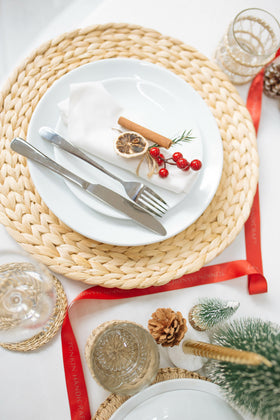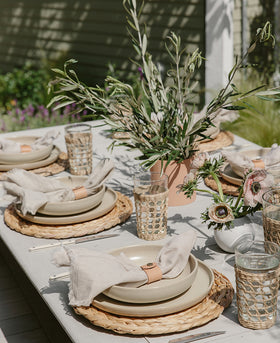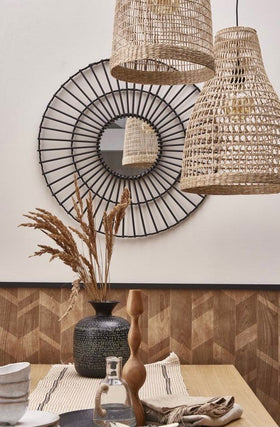
Unveiling Nam Dinh's Crafted Legacy
Bamboo is a versatile plant that has been used for various purposes, from building materials to clothing and food. In recent years, bamboo has gained popularity as an eco-friendly alternative to traditional wood and plastic products. Some countries have even started cultivating bamboo to create new land for agriculture and forestry. In this introduction, we will explore the land in Vietnam which is well-known for traditional bamboo manufacturing and the process of making products using bamboo.

Bamboo is sustainable and eco-friendly material that has been used for generations in Vietnam. They are lightweight, durable, and flexible, making them ideal for manufacturing a variety of kitchen and decor products such as bowls, utensils, trays, baskets etc.
Nam Dinh province in Vietnam is renowned for its long-standing tradition of bamboo handicraft production. The local artisans in this region have mastered the art of recreating products from a very familiar material in Vietnam - bamboo, creating beautiful and intricate designs that are both functional and decorative.
The land considered the father of the weaving profession is also the place where bamboo-making exists and develops. Making bamboo products in Nam Dinh has existed and developed since ancient times.

Nam Dinh's bamboo production is not only a profession but a cultural heritage that has been passed down from generation to generation. It is a source of pride for the people in this area and a testament to their creativity and craftsmanship.
The province's favorable meteorology, terrain, and cultural heritage all contribute to its suitability for bamboo craftsmanship.
-
Meteorology: Nam Dinh experiences a tropical monsoon climate, characterized by warm temperatures, abundant rainfall, and distinct wet and dry seasons. This climate promotes the growth of bamboo forests, providing a readily available source of raw material for artisans. The moderate temperatures and ample moisture also ensure bamboo's flexibility and strength, essential qualities for crafting durable and aesthetically pleasing products.
-
Terrain: Nam Dinh's diverse topography, ranging from flat lowlands to undulating hills and mountainous regions, provides a variety of microclimates suitable for different bamboo species to thrive. This diversity ensures a steady supply of bamboo with varying properties, catering to the specific needs of different bamboo craft products. The province's extensive network of rivers and waterways also facilitates the transportation of bamboo from forests to workshops, minimizing damage and preserving the quality of the material.
-
People and Cultural Heritage: Nam Dinh boasts a rich cultural heritage deeply intertwined with bamboo craftsmanship. For generations, local artisans have passed down their knowledge and skills, refining techniques and developing unique designs that have become synonymous with the province. This cultural legacy has fostered a deep appreciation for bamboo crafts among the local population, providing a strong foundation for the industry to flourish.

The process of making bamboo products in Vietnam involves a series of meticulous steps, each contributing to the creation of exquisite and durable pieces. The traditional techniques passed down through generations have been refined over time, resulting in a harmonious blend of craftsmanship and artistry.
-
Harvesting Bamboo:
The journey begins with the selection of bamboo from mature forests. Artisans carefully choose bamboo stalks that are straight, smooth, and free from blemishes. The stalks are then cut to the desired length and transported to workshops for further processing.
-
Processing:
Once the bamboo stalks arrive at the workshop, they are thoroughly cleaned and dried to remove any moisture or impurities. The dried stalks are then split into thin strips using a sharp knife or specialized tools. The thickness and width of the strips depend on the specific product being made. Strips might be soaked in water to make them more pliable and easier to work with.
-
Shaping and Weaving:
For baskets and other woven products, the prepared bamboo strips are then shaped and woven into the desired form. This intricate process involves a combination of techniques, including coiling, twining, and plaiting. Artisans use their hands and simple tools to manipulate flexible bamboo strips, creating intricate patterns and designs.

For spun bamboo bowls and other pressed bamboo products, the prepared bamboo strips are shaped and pressed into the forms using specified machines. After the initial shaping, the bamboo product is carefully sanded to smoothen out any rough edges and imperfections. This process ensures a smooth and aesthetically pleasing finish. Finally, the bamboo products are treated with a protective coating, such as lacquer or varnish.
This time-honored tradition that dates back many centuries in Nam Dinh, Vietnam, holds immense significance, representing the province's rich cultural heritage and its people's ingenuity. These crafts, passed down through generations, embody the spirit of creativity and resilience, adapting to changing times while preserving their essence.






